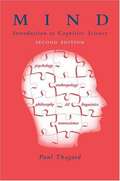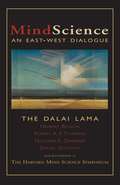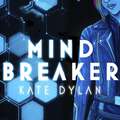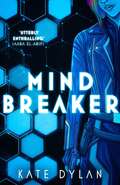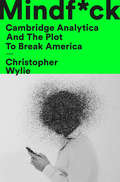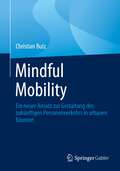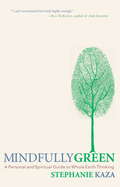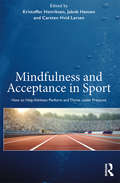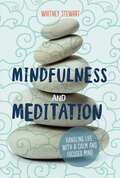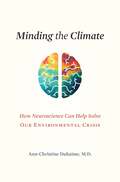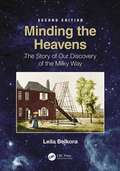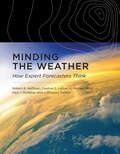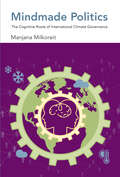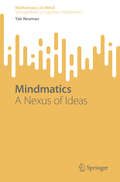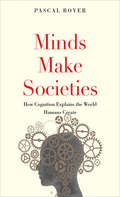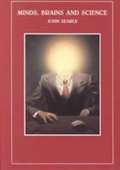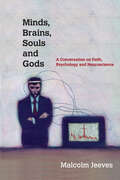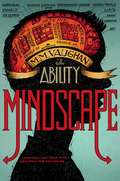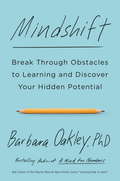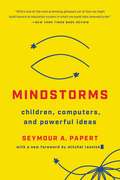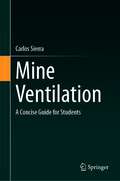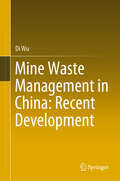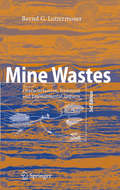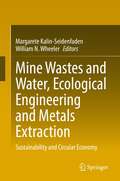- Table View
- List View
Mind: Introduction to Cognitive Science (2nd edition)
by Paul ThagardCognitive science approaches the study of mind and intelligence from an interdisciplinary perspective, working at the intersection of philosophy, psychology, artificial intelligence, neuroscience, linguistics, and anthropology. With Mind, Paul Thagard offers an introduction to this interdisciplinary field for readers who come to the subject with very different backgrounds. It is suitable for classroom use by students with interests ranging from computer science and engineering to psychology and philosophy. Thagard's systematic descriptions and evaluations of the main theories of mental representation advanced by cognitive scientists allow students to see that there are many complementary approaches to the investigation of mind. The fundamental theoretical perspectives he describes include logic, rules, concepts, analogies, images, and connections (artificial neural networks). The discussion of these theories provides an integrated view of the different achievements of the various fields of cognitive science. This second edition includes substantial revision and new material. Part I, which presents the different theoretical approaches, has been updated in light of recent work the field. Part II, which treats extensions to cognitive science, has been thoroughly revised, with new chapters added on brains, emotions, and consciousness. Other additions include a list of relevant Web sites at the end of each chapter and a glossary at the end of the book. As in the first edition, each chapter concludes with a summary and suggestions for further reading.
MindScience
by Daniel Goleman Herbert Benson Robert Thurman His Holiness the Dalai Lama Howard GardnerWhat is the subtle relationship between mind and body? What can today's scientists learn about this relationship from masters of Buddhist thought? Is it possible that by combining Western and Eastern approaches, we can reach a new understanding of the nature of the mind, the human potential for growth, the possibilities for mental and physical health? MindScience explores these and other questions as it documents the beginning of a historic dialogue between modern science and Buddhism. The Harvard Mind Science Symposium brought together the Dalai Lama and authorities from the fields of psychiatry, psychology, neuroscience, and education. Here, they examine myriad questions concerning the nature of the mind and its relationship to the body.
Mindbreaker
by Kate DylanSet in the same world as the extraordinary Mindwalker, Mindbreaker is an action packed young adult science fiction novel asking: what would you sacrifice to survive?They saved her life. But at what cost?Born into a religious, anti-tech cult, seventeen-year-old Indra lives a simple, mod-free existence on the fringe of society. But when an illicit trip to the city leaves her with a debilitating - and terminal - condition, Indra must make a choice: die faithful, or betray her Order and accept the cure Glindell Technologies is offering. Forced to sign over full ownership of her life, Indra is horrified to learn how Glindell chose to save her mind and body. On the outside, she still looks the same. On the inside, Indra's not so sure. She's missing time, for one thing, and more than once, she finds herself in places she really shouldn't be, with no memory of how she got there and abilities she can't explain.So when news breaks of a vicious attack against Glindell's biggest rival, Indra begins to suspect the worst about her new master. With help from her one friend at the company, Tian - a research assistant with a genius IQ and a smile that won't quit - Indra manages to escape the lab. Then together with the anti-corp faction she and Tian turn to for help, Indra must uncover the truth behind the procedure that saved her life, before Glindell can use it to change the face of technology - and what it means to be human - forever.(P) 2023 Hodder & Stoughton Limited
Mindbreaker
by Kate DylanNo more quiet rebellions.'A dystopian thriller that fizzes with energy and rebellion' SAMANTHA SHANNONAn explosive cyberpunk SF thriller from the author of Mindwalker, set in a world of corporate intrigue and dangerous technology. Born into a religious cult on the fringe of society, Indra Dyer lives a simple, tech-free existence. But when an illicit trip to the city leaves her with a debilitating - and terminal - condition, Indra must make a choice: die faithful or betray her Order and accept the cure Glindell Technologies is offering. Forced to sign over full ownership of her life, Indra is horrified to learn the true nature of Glindell's plans. Instead of saving her body, they upload her mind to a first-of-its-kind MindDrive, housed in a fully robotic shell. On the outside, Indra still looks the same; on the inside, she's not so sure. She keeps finding herself in places she really shouldn't be, with no memory of how she got there, and dangerous abilities she can't explain. So when news breaks of an attack against Glindell's biggest rival, Indra suspects the worst. With the help of Tian - a research assistant with questionable morals and a smile that won't quit - Indra must uncover the truth behind the procedure that saved her life, before Glindell can use it to change the face of technology, and what it means to be human, forever . . .PRAISE FOR KATE DYLAN'Witty, gritty, and vicious fun' HANNAH KANER'An invigorating ride at breakneck speed . . . Electric' SAARA EL-ARIFI'The thrill ride of a lifetime' KAT DUNN'Pure adrenaline shot straight into your veins' JESSE Q. SUTANTO'Sharp-edged, tense and thrilling, you'll be holding your breath until the last page' TASHA SURI
Mindbreaker
by Kate DylanNo more quiet rebellions.'A dystopian thriller that fizzes with energy and rebellion' SAMANTHA SHANNONAn explosive cyberpunk SF thriller from the author of Mindwalker, set in a world of corporate intrigue and dangerous technology. Born into a religious cult on the fringe of society, Indra Dyer lives a simple, tech-free existence. But when an illicit trip to the city leaves her with a debilitating - and terminal - condition, Indra must make a choice: die faithful or betray her Order and accept the cure Glindell Technologies is offering. Forced to sign over full ownership of her life, Indra is horrified to learn the true nature of Glindell's plans. Instead of saving her body, they upload her mind to a first-of-its-kind MindDrive, housed in a fully robotic shell. On the outside, Indra still looks the same; on the inside, she's not so sure. She keeps finding herself in places she really shouldn't be, with no memory of how she got there, and dangerous abilities she can't explain. So when news breaks of an attack against Glindell's biggest rival, Indra suspects the worst. With the help of Tian - a research assistant with questionable morals and a smile that won't quit - Indra must uncover the truth behind the procedure that saved her life, before Glindell can use it to change the face of technology, and what it means to be human, forever . . .PRAISE FOR KATE DYLAN'Witty, gritty, and vicious fun' HANNAH KANER'An invigorating ride at breakneck speed . . . Electric' SAARA EL-ARIFI'The thrill ride of a lifetime' KAT DUNN'Pure adrenaline shot straight into your veins' JESSE Q. SUTANTO'Sharp-edged, tense and thrilling, you'll be holding your breath until the last page' TASHA SURI
Mindf*ck: Cambridge Analytica and the Plot to Break America
by Christopher WylieFor the first time, the Cambridge Analytica whistleblower tells the inside story of the data mining and psychological manipulation behind the election of Donald Trump and the Brexit referendum, connecting Facebook, WikiLeaks, Russian intelligence, and international hackers. <P><P>Mindf*ck goes deep inside Cambridge Analytica’s “American operations,” which were driven by Steve Bannon’s vision to remake America and fueled by mysterious billionaire Robert Mercer’s money, as it weaponized and wielded the massive store of data it had harvested on individuals—in excess of 87 million—to disunite the United States and set Americans against each other. Bannon had long sensed that deep within America’s soul lurked an explosive tension. <P><P>Cambridge Analytica had the data to prove it, and in 2016 Bannon had a presidential campaign to use as his proving ground. Christopher Wylie might have seemed an unlikely figure to be at the center of such an operation. Canadian and liberal in his politics, he was only twenty-four when he got a job with a London firm that worked with the U.K. Ministry of Defense and was charged putatively with helping to build a team of data scientists to create new tools to identify and combat radical extremism online. In short order, those same military tools were turned to political purposes, and Cambridge Analytica was born. <P><P>Wylie’s decision to become a whistleblower prompted the largest data-crime investigation in history. His story is both exposé and dire warning about a sudden problem born of very new and powerful capabilities. It has not only laid bare the profound vulnerabilities—and profound carelessness—in the enormous companies that drive the attention economy, it has also exposed the profound vulnerabilities of democracy itself. What happened in 2016 was just a trial run. Ruthless actors are coming for your data, and they want to control what you think.
Mindful Mobility: Ein neuer Ansatz zur Gestaltung des zukünftigen Personenverkehrs in urbanen Räumen
by Christian ButzDie aktuelle Entwicklung der Mobilität in urbanen Räumen stellt alle Beteiligten vor große Herausforderungen. Zunehmende Versorgungströme und der Wunsch nach individueller Mobilität bringen die Verkehrsinfrastruktur an ihre Grenzen. Nachteilige Folgen sind Staus, Luft- und Lärmbelastung sowie zunehmend Schäden an Verkehrsflächen, deren Erhaltung enorme Kosten verursacht und im täglichen Betrieb des urbanen Lebens einen hohen Aufwand und vielfältige Einschränkungen bedeuten. Gesellschaft, Politik und Unternehmen sind gefordert, geeignete Lösungen zu entwickeln und umzusetzen. Dabei müssen ökologische, ökonomische und soziale Themen mit dem Ziel einer Mindful Mobility ausgewogen berücksichtigt werden.Dieses Buch zeigt anhand eines Reifegradmodells nachhaltige Konzepte, Beispiele und schrittweise Lösungen für den urbanen Raum und die Mobilität.
Mindfully Green: A Personal and Spiritual Guide to Whole Earth Thinking
by Stephanie KazaWith all the attention on living sustainably, the one thing missing from the conversation is how to find a personal connection with green living that will sustain us on our green path. While practical approaches to an eco-responsible lifestyle offer important first steps, it is critical that we ground these actions in broader understanding so that we can effect real change in the world. In this book, Stephanie Kaza describes what she calls the "green practice path." She offers a simple, Buddhist-inspired philosophy for taking up environmental action in real, practical, and effective ways. Discover new ways to think more deeply about your impact on the natural world, engage in environmental change, and make green living a personal practice based in compassion and true conviction.
Mindfulness and Acceptance in Sport: How to Help Athletes Perform and Thrive under Pressure
by Kristoffer Henriksen Jakob Hansen Carsten Hvid LarsenMindfulness- and acceptance-based approaches such as Acceptance and Commitment Therapy (ACT) and Mindfulness Acceptance Commitment (MAC) are gaining momentum with sport psychology practitioners who work to support elite athletes. These acceptance-based, or third wave, cognitive behavioral approaches in sport psychology highlight that thought suppression and control techniques can trigger a metacognitive scanning process, and that excessive cognitive activity and task-irrelevant focus (self-focused attention such as trying to change thoughts) disrupts performance. Using this perspective, the aim of sport psychology interventions is not to help the athletes engage in the futile task of managing and controlling internal life. Rather, it suggests that sport psychology practitioners should work to increase athletes’ willingness to accept negative thoughts and emotions in pursuit of valued ends. Key aspects of such interventions include: teaching athletes to open up and accept, teaching athletes to mindfully engage in the present moment, and helping athletes formulate the values and engage in committed actions towards these values. The goal of Mindfulness and Acceptance in Sport: How to Help Athletes Perform and Thrive under Pressure then is to provide students, researchers, practitioners, and coaches of sport psychology with practical guidance for implementing mindfulness and acceptance approaches in their work with athletes. This book brings together highly experienced practitioners and shares their working methods, exercises, and cases to inspire the sport psychology profession.
Mindfulness and Meditation: Handling Life with a Calm and Focused Mind
by Whitney StewartFrom hormones to homework, parents to peers, health issues to bad habits, life can be a pressure cooker. How can we find relief? Author Whitney Stewart introduces readers to the practice of mindfulness. With its roots in ancient Buddhist teachings, mindfulness—the practice of purposefully focusing attention on the present moment—can change a person's approach to stress, develop skills to handle anxiety and depression, and provide a sense of awareness and belonging. Stewart guides readers through how to get started with meditation as well as provides specific exercises for examining emotions, managing stress, checking social media habits and wellness routines, and setting intentions to increase happiness. "A thorough and accessible resource for young people."—Kirkus Reviews "Considering the range of challenges that today's teens face, equipping them with pertinent coping skills is crucial for their future success and well-being. . . . [S]traightforward and refreshing."—School Library Journal
Minding the Climate: How Neuroscience Can Help Solve Our Environmental Crisis
by Ann-Christine DuhaimeA neurosurgeon explores how our tendency to prioritize short-term consumer pleasures spurs climate change, but also how the brain’s amazing capacity for flexibility can—and likely will—enable us to prioritize the long-term survival of humanity.Increasingly politicians, activists, media figures, and the public at large agree that climate change is an urgent problem. Yet that sense of urgency rarely translates into serious remedies. If we believe the climate crisis is real, why is it so difficult to change our behavior and our consumer tendencies?Minding the Climate investigates this problem in the neuroscience of decision-making. In particular, Ann-Christine Duhaime, MD, points to the evolution of the human brain during eons of resource scarcity. Understandably, the brain adapted to prioritize short-term survival over more uncertain long-term outcomes. But the resulting behavioral architecture is poorly suited to the present, when scarcity is a lesser concern and slow-moving, novel challenges like environmental issues present the greatest danger. Duhaime details how even our acknowledged best interests are thwarted by the brain’s reward system: if a behavior isn’t perceived as immediately beneficial, we probably won’t do it—never mind that we “know” we should. This is what happens when we lament climate change while indulging the short-term consumer satisfactions that ensure the disaster will continue.Luckily, we can sway our brains, and those of others, to alter our behaviors. Duhaime describes concrete, achievable interventions that have been shown to encourage our neurological circuits to embrace new rewards. Such small, incremental steps that individuals take, whether in their roles as consumers, in the workplace, or in leadership positions, are necessary to mitigate climate change. The more we understand how our tendencies can be overridden by our brain’s capacity to adapt, Duhaime argues, the more likely we are to have a future.
Minding the Heavens: The Story of our Discovery of the Milky Way
by Leila BelkoraToday, we recognize that we live on a planet circling the sun, that our sun is just one of billions of stars in the galaxy we call the Milky Way, and that our galaxy is but one of billions born out of the Big Bang. Yet as recently as the early twentieth century, the general public and even astronomers had vague and confused notions about what lay beyond the visible stars. Can we see to the edge of the universe? Do we live in a system that would look, from a distance, like a spiral nebula? This fully updated second edition of Minding the Heavens: The Story of Our Discovery of the Milky Way explores how we learned that we live in a galaxy, in a universe of composed of galaxies and unseen, mysterious dark matter. The story unfolds through short biographies of seven astronomers: Thomas Wright, William Herschel, and Wilhelm Struve of the 18th and 19th centuries; the transitional figure of William Huggins; and Jacobus Kapteyn, Harlow Shapley, and Edwin Hubble of the modern, big-telescope era. Each contributed key insights to our present understanding of where we live in the cosmos, and each was directly inspired by the work of his predecessors to decipher "the construction of the heavens." Along the way the narrative weaves in the contributions of those in supportive roles, including Caroline Herschel—William’s sister, and the first woman paid to do astronomy—and Martha Shapley, a mathematician in her own right who carried out calculations for her spouse. Through this historical perspective readers will gain a new appreciation of our magnificent Milky Way galaxy and of the beauties of the night sky, from ghostly nebulae to sparkling star clusters. Features: Fully updated throughout to reflect the latest in our understanding of the Milky Way, from our central supermassive black hole to the prospect of future mergers with other galaxies in our Local Group. Explains the significance of current research, including from the Gaia mission mapping our galaxy in unprecedented detail Unique and broadly appealing approach. A biographical framework and ample illustrations lead the reader by easy, enjoyable steps to a well-rounded understanding of the history of astronomy. Praise for the first edition— "A terrific blend of the science and the history." - Marth Haynes, Goldwin Smith Professor of Astronomy, Cornell University "The book is a treat… Highly recommended for public and academic libraries." -Peter Hepburn (now Head Librarian, College of the Canyons, Santa Clarita, California)
Minding the Weather: How Expert Forecasters Think (The\mit Press Ser.)
by H. Michael Mogil Robert R. Hoffman Daphne S. Ladue Paul J. Roebber J. Gregory TraftonA detailed study of research on the psychology of expertise in weather forecasting, drawing on findings in cognitive science, meteorology, and computer science.This book argues that the human cognition system is the least understood, yet probably most important, component of forecasting accuracy. Minding the Weather investigates how people acquire massive and highly organized knowledge and develop the reasoning skills and strategies that enable them to achieve the highest levels of performance.The authors consider such topics as the forecasting workplace; atmospheric scientists' descriptions of their reasoning strategies; the nature of expertise; forecaster knowledge, perceptual skills, and reasoning; and expert systems designed to imitate forecaster reasoning. Drawing on research in cognitive science, meteorology, and computer science, the authors argue that forecasting involves an interdependence of humans and technologies. Human expertise will always be necessary.
Mindmade Politics: The Cognitive Roots of International Climate Governance (The\mit Press Ser.)
by Manjana MilkoreitHow integrating cognitive theories and international relations scholarship can yield valuable insights into the effectiveness of climate negotiations.Mindmade Politics takes a novel, interdisciplinary approach to understanding the complex and contentious dynamics of global climate politics. Manjana Milkoreit argues that integrating cognitive theories and international relations scholarship can yield valuable insights into multilateral cooperation (or the lack of it) on climate change and the process of negotiating climate agreements. Milkoreit argues that cognition is at the root of all political behavior and decision making. Some of the most important variables of international relations scholarship—the motivations of political actors—are essentially cognitive variables. Drawing on interviews with participants in the United Nations Framework Convention on Climate Change (UNFCCC), Milkoreit examines the thoughts, beliefs, and emotions of individuals and groups, focusing on the mental mechanisms connecting decision-relevant factors and observed political behavior. Milkoreit offers a brief introduction to international relations theory and key insights regarding the politics of climate change; outlines the basic cognitive theories and concepts that she applies in her analysis, discussing the cognitive challenges of climate change; and describes the integrated methodological approach she used for her cognitive-political analysis. She presents four cognitive-affective lessons for global change politics, including the “cognitive triangle” of three major concerns of climate negotiators—threat, identity, and justice—and she identifies six major belief systems driving negotiators. Finally, she offers guidance for climate governance based on her findings. Utilizing recent advances in cognitive science, Milkoreit builds a theoretical bridge between two major disciplines that will benefit both scholars and practitioners.
Mindmatics: A Nexus of Ideas (Mathematics in Mind)
by Yair NeumanMindmatics invites readers into a captivating exploration where the boundaries between mind and mathematics dissolve. Professor Neuman delves into the profound connections between cognitive processes and mathematical expression in this groundbreaking work. From how children grasp abstract concepts to symmetry's role in art and mathematics, this book uncovers the hidden structures that shape our understanding of the world. With insightful discussions on the relationship between poetry and mathematics and the essential role of the unconscious in fostering mathematical imagination, Mindmatics offers a unique perspective on the interplay of thought, creativity, and logic. This book is a must-read for anyone curious about the deeper links between the human mind and the mathematical universe.
Minds Make Societies: How Cognition Explains the World Humans Create
by Pascal BoyerA scientist integrates evolutionary biology, genetics, psychology, economics, and more to explore the development and workings of human societies. &“There is no good reason why human societies should not be described and explained with the same precision and success as the rest of nature.&” Thus argues evolutionary psychologist Pascal Boyer in this uniquely innovative book. Integrating recent insights from evolutionary biology, genetics, psychology, economics, and other fields, Boyer offers precise models of why humans engage in social behaviors such as forming families, tribes, and nations, or creating gender roles. In fascinating, thought-provoking passages, he explores questions such as: Why is there conflict between groups? Why do people believe low-value information such as rumors? Why are there religions? What is social justice? What explains morality? Boyer provides a new picture of cultural transmission that draws on the pragmatics of human communication, the constructive nature of memory in human brains, and human motivation for group formation and cooperation.&“Cool and captivating…It will change forever your understanding of society and culture.&”—Dan Sperber, co-author of The Enigma of Reason&“It is highly recommended…to researchers firmly settled within one of the many single disciplines in question. Not only will they encounter a wealth of information from the humanities, the social sciences and the natural sciences, but the book will also serve as an invitation to look beyond the horizons of their own fields.&”—Eveline Seghers, Evolutionary Studies in Imaginative Culture
Minds, Brains And Science
by John SearleMinds, Brains and Science takes up just the problems that perplex people, and it does what good philosophy always does: it dispels the illusion caused by the specious collision of truths. How do we reconcile common sense and science? John Searle argues vigorously that the truths of common sense and the truths of science are both right and that the only question is how to fit them together. <p><p> Searle explains how we can reconcile an intuitive view of ourselves as conscious, free, rational agents with a universe that science tells us consists of mindless physical particles. He briskly and lucidly sets out his arguments against the familiar positions in the philosophy of mind, and details the consequences of his ideas for the mind-body problem, artificial intelligence, cognitive science, questions of action and free will, and the philosophy of the social sciences.
Minds, Brains, Souls and Gods: A Conversation on Faith, Psychology and Neuroscience
by Malcolm JeevesMinds, Brains, Souls and Gods,Do I have a soul?How free am I?What makes me uniquely human?Does my brain have a "God spot"?In this hypothetical correspondence with a student, Jeeves argues that we must avoid false choices in the relation between Scripture and science. Christians need not choose between a "God of the gaps" that competes with science, a "neurotheology" that bases our understanding of God on the latest scientific theory, or a scientific reductionism that claims to have explained God away as a mere function of the brain. Students encountering the brave new world of neuroscience need not view such research as a threat to the faith. With the wisdom of a seasoned scholar, Jeeves guides us down the road less-traveled—the way of integration.
Mindscape
by Iacopo Bruno M. M. VaughanTelekinetic preteens use their powers for good--and evil--in this mind-bending sequel to The Ability, which Publishers Weekly called a "fast-paced, superhero-tinged spy novel."Everywhere that Christopher Lane turns, he sees the face of the boy he killed. There is no escape from the guilt, not even on his return to Myers Holt--the secret London academy where he and five others are being trained to use their mental powers, their Ability. But now that the threat of Dulcia Genever has been dealt with, his friends are too busy working for the police, entering the minds of some of the country's most dangerous criminals, to sympathize. Chris's teachers are already concerned enough about him, especially when Chris starts to wonder if the boy may not be a figment of his imagination after all. Meanwhile, alone in Darkwhisper Manor, Ernest Genever is enjoying watching Chris's torment. Yes, he will keep his promise--Christopher Lane will die--but not until he has watched Chris lose his mind waiting for Ernest to appear. For, if nothing else, Dulcia Genever did teach her son one valuable lesson: Revenge is a dish best served cold.
Mindshift: Break Through Obstacles to Learning and Discover Your Hidden Potential
by Barbara OakleyMindshift reveals how we can overcome stereotypes and preconceived ideas about what is possible for us to learn and become. At a time when we are constantly being asked to retrain and reinvent ourselves to adapt to new technologies and changing industries, this book shows us how we can uncover and develop talents we didn’t realize we had—no matter what our age or background. We’re often told to “follow our passions.” But in Mindshift, Dr. Barbara Oakley shows us how we can broaden our passions. Drawing on the latest neuroscientific insights, Dr. Oakley shepherds us past simplistic ideas of “aptitude” and “ability,” which provide only a snapshot of who we are now—with little consideration about how we can change. Even seemingly “bad” traits, such as a poor memory, come with hidden advantages—like increased creativity. Profiling people from around the world who have overcome learning limitations of all kinds, Dr. Oakley shows us how we can turn perceived weaknesses, such as impostor syndrome and advancing age, into strengths. People may feel like they’re at a disadvantage if they pursue a new field later in life; yet those who change careers can be fertile cross-pollinators: They bring valuable insights from one discipline to another. Dr. Oakley teaches us strategies for learning that are backed by neuroscience so that we can realize the joy and benefits of a learning lifestyle. Mindshift takes us deep inside the world of how people change and grow. Our biggest stumbling blocks can be our own preconceptions, but with the right mental insights, we can tap into hidden potential and create new opportunities.From the Trade Paperback edition.
Mindstorms: Children, Computers, And Powerful Ideas
by Seymour A. PapertIn this revolutionary book, a renowned computer scientist explains the importance of teaching children the basics of computing and how it can prepare them to succeed in the ever-evolving tech world.Computers have completely changed the way we teach children. We have Mindstorms to thank for that. In this book, pioneering computer scientist Seymour Papert uses the invention of LOGO, the first child-friendly programming language, to make the case for the value of teaching children with computers. Papert argues that children are more than capable of mastering computers, and that teaching computational processes like de-bugging in the classroom can change the way we learn everything else. He also shows that schools saturated with technology can actually improve socialization and interaction among students and between students and teachers.Technology changes every day, but the basic ways that computers can help us learn remain. For thousands of teachers and parents who have sought creative ways to help children learn with computers, Mindstorms is their bible.
Mine Ventilation: A Concise Guide for Students
by Carlos SierraThis textbook focuses on underground ventilation, addressing both theoretical and practical aspects. Readers will develop a deeper understanding of mine ventilation and adjacent areas of research. The content is clearly structured, moving through chapters in a pedagogical way. It begins by presenting an introduction to fluid mechanics, before discussing the environmental conditions in mines, underground fire management, and international legislation concerning mines. Particular attention is paid to development ends ventilation, an area that is underrepresented in scientific research. Each chapter includes a concise theoretical summary, followed by several worked-out examples, problems and questions to develop students’ skills.This textbook will be useful for undergraduate and master’s degree students around the world. In addition, the large number of practical cases included make it particularly well suited to preparing for professional engineer examinations and as a guide for practising engineers.
Mine Waste Management in China: Recent Development
by Di WuThis book introduces recent development of technologies for mine waste management in China. For hard rock mines, the main mine wastes are tailings, and the tailings can be disposed above-ground and/or underground. The technology of consolidated tailings stockpile (CTS) that disposes tailings above-ground is introduced, and the application of this technology is also demonstrated. Besides, the technology of cemented tailings (or paste) backfill (CTB or CPB) which deals with tailings underground is also discussed. The properties of CTB materials and the utilization of CTB technology are described and analyzed. For coal mines, the main mine wastes are coal gangue and fly ash. The technology of cemented coal gangue-fly ash backfill (CGFB) that manages coal mine waste underground is presented. The THMC coupling properties of CGFB materials are investigated, which can contribute to a better design of stable, durable and environmentally friendly CGFB mixtures. The application of CGFB technology in a coal mine is also presented. This book, which systematically reviews and discusses the development of mine waste management technologies in China, is expected to provide readers comprehensive information about mine waste management.
Mine Wastes
by Bernd LottermoserThis book provides a thorough, up-to-date overview of wastes accumulating at mine sites. It deals comprehensively with sulfidic mine wastes, mine water, tailings, cyanidation wastes of gold-silver ores, radioactive wastes of uranium ores, and wastes of phosphate and potash ores. The book emphasizes the characterization, prediction, monitoring, disposal and treatment as well as environmental impacts of problematic mine wastes. The strong pedagogical framework is supported by case studies from around the world, presentation of crucial aspects of mine wastes as scientific issues; end-of-chapter summaries as well as lists of resource materials and www sites for each waste type. The considerably updated third edition has novel and notable changes including: revision of text to reflect major developments and contemporary issues that are taking place in the field of mine waste science; new web pages at the end of each chapter; over 20 case studies and scientific issues; over 150 figures and tables; and an updated bibliography with over 1200 references. This newly balanced text will continue to equip the student and the professional with a thorough understanding of the principles and processes of mine wastes.
Mine Wastes and Water, Ecological Engineering and Metals Extraction: Sustainability and Circular Economy
by Margarete Kalin-Seidenfaden William N. WheelerThe book reviews past and present mine waste management processes. It estimates global water consumption by major mining resources per annum. This consumption will lead land use resources (agriculture and water) to collide with mining interests expected in the near future. With the application of novel metal extraction processes and the adoption of ecological engineering as an approach to waste and water management, a reduction in water and land consumption can be achieved. Using these methodologies would make mining more sustainable. Together with ore and metal recycling, mining methods can be brought into the 21st century. The book describes natural weathering processes and the microbiology of extreme environments, also known as mine sites. The role of microbes in weathering and remediation is emphasized, along with case studies of the enhancement of various ecological processes which curtail weathering and transform pollutants, creating ore bodies of the future.This book has been written as an extension to a contribution to the Oxford Research Encyclopedia. It adds depth and many examples from 40 years of multidisciplinary work with experts from geology, hydrogeology, geomicrobiology and algal physiology and chemistry, items too extensive for the Encyclopedia.
